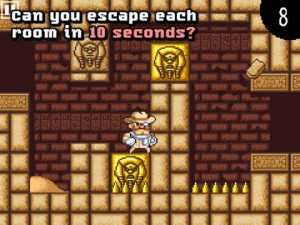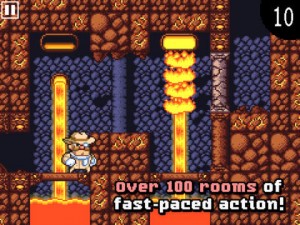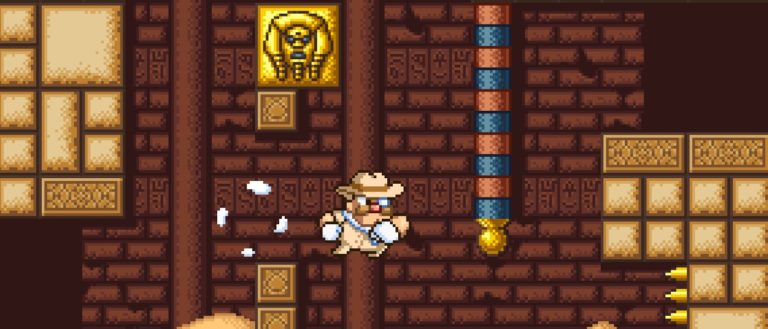Many a great indie idea has come from the Ludum Dare — a competition whose name literally means: “to give a name” — wherein people are challenged to make a game fitting a bizarre game play mandate, all within the hyper-condensed span of just two days. Between the extreme two day time-limit — and the bizarre mandates — designers from the entire world over are forced to come up with concepts of absolute pure game play, most often the likes of which have never before been seen. Curiously the results of this are often like American Idol, where — although many ideas showcased during the competition will later achieve financial success — the first place winners are almost always forgotten.
 Jussi Simpanen’s Duke Dashington (out now, $0.99) is yet another one of those games that didn’t take first place, and strove to tackle the dilemma of how to make coherent — and otherwise still meaningful — game play meant to be solved within only ten seconds. He defeated this challenge by presenting us with a brave archaeologist — named Duke Dashington — whom scours the world for priceless artifacts, and yet somehow all of the ancient temples that Duke discovers promptly begin collapsing whenever he arrives. Therefore the Duke — whom won’t allow historical relics to be lost forever — has been left with no choice but to charge headfirst into these ruddy places, making extra sure to always keep moving forward because each chamber will collapse after just ten seconds!
Jussi Simpanen’s Duke Dashington (out now, $0.99) is yet another one of those games that didn’t take first place, and strove to tackle the dilemma of how to make coherent — and otherwise still meaningful — game play meant to be solved within only ten seconds. He defeated this challenge by presenting us with a brave archaeologist — named Duke Dashington — whom scours the world for priceless artifacts, and yet somehow all of the ancient temples that Duke discovers promptly begin collapsing whenever he arrives. Therefore the Duke — whom won’t allow historical relics to be lost forever — has been left with no choice but to charge headfirst into these ruddy places, making extra sure to always keep moving forward because each chamber will collapse after just ten seconds!
At this point I’d like to take a moment to point out that — as far as Ludum Dare competitions go — this actually wasn’t the most original of challenges so far, seeing as how Nintendo themselves released WarioWare, Inc.: Mega Microgame$! back in 2003. The game challenged players to play through a long series of randomly shuffled — and wildly different — miniature games, and the player was generally auto-failed if they didn’t tackle the challenge at hand in under five seconds (or even less, once things sped up). Nice try, Ludum Dare, but apparently this time around one of the big three game companies — humorously using one of the greediest videogame mascots of all time — actually beat you to the punch for pioneering this unlikely innovation.
 Anyways — getting back to the task at hand — there are two control schemes to choose from in Duke Dashington: one where players have on screen buttons for dashing and jumping, and another where they will instead swipe in the direction they wish to proceed. I personally preferred to use the on screen buttons since — during the later parts of Duke’s adventures — the player will begin to regularly be faced with situations demanding nearly pixel-perfect timing, and the swipe based actions just weren’t really cutting it for me. However — no matter which method you choose — here are some rules that will guide you: Duke can only jump when he’s touching the ground, he can only dash when he’s not already in the process of dashing, and he can only come to a stop if he slams into stuff.
Anyways — getting back to the task at hand — there are two control schemes to choose from in Duke Dashington: one where players have on screen buttons for dashing and jumping, and another where they will instead swipe in the direction they wish to proceed. I personally preferred to use the on screen buttons since — during the later parts of Duke’s adventures — the player will begin to regularly be faced with situations demanding nearly pixel-perfect timing, and the swipe based actions just weren’t really cutting it for me. However — no matter which method you choose — here are some rules that will guide you: Duke can only jump when he’s touching the ground, he can only dash when he’s not already in the process of dashing, and he can only come to a stop if he slams into stuff.
This probably so far sounds as if it would make for a relatively simplistic experience, because — after all — just how engaging could you make a game truly be when everything has to be solved in ten seconds or less? The answer to this is — quite thankfully — that a fairly decent bit of variety is available: water currents that push the hero, spinning spike traps, walls that taking multiple hits to break through, collapsing sections, and so on. Perhaps — however — the greatest source of challenge in Duke Dashington comes from the fact that players can’t directly order themself to stop moving, leaving them to instead use the scenery in creative ways to ensure that Duke ends up halted in an advantageous spot.
 What I will say — however — is that Duke Dashington is somewhat admittedly on the short side, seeing as how it contains precisely four temples (each of which are made up of thirty different rooms). The end result of all this is that the game can obviously be finished — from start to finish — in precisely twelve minutes or less, but you’d fooling yourself if you actually believe that you’ll be able to perform such a feat on your first run. Expect to die often — most commonly to traps, rather than the time limit itself — when you’re still learning Duke Dashington’s ropes, and this will be especially true during the game’s later temples.
What I will say — however — is that Duke Dashington is somewhat admittedly on the short side, seeing as how it contains precisely four temples (each of which are made up of thirty different rooms). The end result of all this is that the game can obviously be finished — from start to finish — in precisely twelve minutes or less, but you’d fooling yourself if you actually believe that you’ll be able to perform such a feat on your first run. Expect to die often — most commonly to traps, rather than the time limit itself — when you’re still learning Duke Dashington’s ropes, and this will be especially true during the game’s later temples.
I would like to point out of that one of these temples is none other than the infamous Hades itself, which — like everything else the Duke finds — begins crumbling almost immediately (I guess you could say the place has really been going to Hell these days).
Thankfully you’ll never find yourself arbitrarily required to reset your progress within these temples, this is simultaneously thanks to your freedom to start at any room you’ve already unlocked — at least during Story Mode — as well as you having unlimited lives. One might think that there should be a Time Trial mode in a game where your lives don’t really matter, and — in fact — it just so happens that Duke Dashington does indeed have an alternate Time Trial mode (complete with Game Center scoreboards). It’s a really good thing that this Time Trial exists too, because otherwise — without it — there’d sadly be very little reason for those whom enjoyed Duke Dashington to keep on returning afterwards.
 Of course you wouldn’t even be concerned with wanting to play a game again — whether it was long or short — if it wasn’t fun to begin with, and I am glad to report that Duke Dashington is actually a total blast to play. With the constant threat of rooms set to fall utterly apart in just ten seconds, Duke Dashington makes you feel like you’re playing through a non-stop series of dangerous Indiana Jones style climactic escape sequences! Furthermore, each of these — admittedly short — rooms have been packed with so much complexity that those ten seconds feel as though far more time has passed, meaning that a short run here can feel far more rewarding than three minutes spent in most other apps.
Of course you wouldn’t even be concerned with wanting to play a game again — whether it was long or short — if it wasn’t fun to begin with, and I am glad to report that Duke Dashington is actually a total blast to play. With the constant threat of rooms set to fall utterly apart in just ten seconds, Duke Dashington makes you feel like you’re playing through a non-stop series of dangerous Indiana Jones style climactic escape sequences! Furthermore, each of these — admittedly short — rooms have been packed with so much complexity that those ten seconds feel as though far more time has passed, meaning that a short run here can feel far more rewarding than three minutes spent in most other apps.
The end result of all this is that Duke Dashington manages to fit extremely well within the often rather limiting time-constraints of a mobile gaming life style, all while still being a genuinely challenging platform-jumping experience all the same.
Finally — with all mechanical matters now aside — there’s one last thing I wanted to cover: how Duke Dashington looks, and specifically whom I think the good Duke’s sprites were largely inspired by. While the game itself features rather nice pixel graphics (which you obviously won’t have much time to properly admire), I just really couldn’t shake the feeling that Duke both looked — and moved — a lot like a very specific Nintendo character. It should quickly become obvious — either by looking at just a few screenshots, or even the trailer — that Duke, and especially his charge dash, are both heavily inspired by Wario (I guess Ludum Dare’s 10-Sec challenge reminded Jussi Simpanen of something as well).
Verdict
You probably wouldn’t believe that you could get a properly jam packed Indiana Jones esque experience in just ten seconds, but Duke Dashington is here to utterly dash all of your misplaced expectations to pieces! With four intense levels that were designed to be finishable within just three minutes each — or less, if you get really good — Duke Dashington is a great game for whenever time is very precious. The inclusion of a Time Trial mode — complete with online scoreboards — ensures that there’s always a motivator for coming back, since there’s always room to shave a few more seconds off of Duke’s trip through that pyramid — Atlantis — or even Hades itself.


